In France, music reflects a diverse array of styles. In the field of classical music, France has produced several prominent romantic composers, while folk and popular music have seen the rise of the chanson and cabaret style. The oldest playable musical recordings were made in France using the earlist known sound recording device in the world, the phonautograph, which was patented by Édouard-Léon Scott de Martinville in 1857. France is also the 5th largest market by value in the world, and its music industry has produced many internationally renowned artists, especially in the nouvelle chanson and electronic music.
Since the early 1970s, Brittany has experienced a tremendous revival of its folk music. Along with flourishing traditional forms such as the bombard-biniou pair and fest-noz ensembles incorporating other additional instruments, it has also branched out into numerous subgenres.
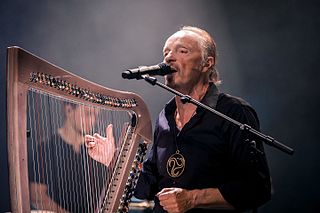
Alan Stivell is a Breton and Celtic musician and singer, songwriter, recording artist, and master of the Celtic harp. From the early 1970s, he revived global interest in the Celtic harp and Celtic music as part of world music. As a bagpiper and bombard player, he modernized traditional Breton music and singing in the Breton language. A precursor of Celtic rock, he is inspired by the union of the Celtic cultures and is a keeper of the Breton culture.

Dan Ar Braz is a Breton guitarist-singer-composer and the founder of L'Héritage des Celtes, a 50-piece Pan-Celt band. Leading guitarist in Celtic music, he recorded as a soloist and with Celtic harp player Alan Stivell. He represented France in the Eurovision Song Contest 1996.
Victoires de la Musique are an annual French award ceremony where the Victoire accolade is delivered by the French Ministry of Culture to recognize outstanding achievement in the music industry. The classical and jazz versions are the Victoires de la musique classique and Victoires du Jazz.
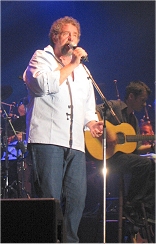
Gilles Servat is a French singer, born in Tarbes in southern France in 1945, into a family whose roots lay in the Nantes region of Brittany. He is an ardent promoter ardent of the Breton culture, and sings in both French and Breton, as well as the other celtic languages, and was a member of Dan ar Braz's Héritage des Celtes. He is also a poet and novelist.
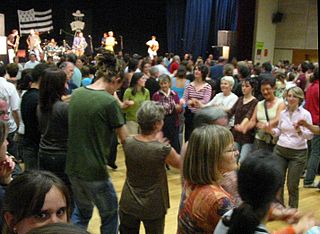
An dro or en dro is a Breton folk dance in 4
4. It is a form of a circle dance.
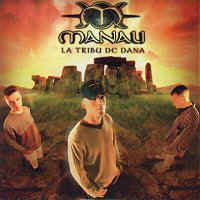
"La Tribu de Dana" is a 1998 song by French hip hop band Manau for their debut album Panique celtique, on which it features as the second track. Initially released as a single in July 1998, it was an immediate success, particularly in France, where it topped singles charts for many months and became one of the best-selling singles in France at the time.

"Mais qui est la belette ?" is a 1998 song recorded by French hip hop act Manau. It was the third single from its album Panique celtique and was released in December 1998. It achieved success, becoming a number-one hit in France and Belgium (Wallonia), although its sales were not as high as the first single of the album, "La Tribu de Dana".
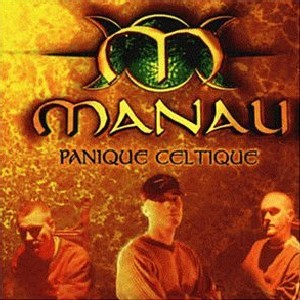
Panique celtique is the debut album recorded by French hip hop act Manau. It was released in July 1998. It achieved success in France and Belgium (Wallonia) where it hit respectively #1 for several weeks and #2. It provided five singles : the two number-one hits "La Tribu de Dana" and "Mais qui est la belette ?", a top nine hit "Panique celtique", and two top 40 hits "L'avenir est un long passé" and "La Confession".

Renaissance de la Harpe Celtique or Renaissance of the Celtic Harp is a 1972 record album by the Breton master of the Celtic harp Alan Stivell that revolutionised the connection between traditional folk music, modern rock music and world music.
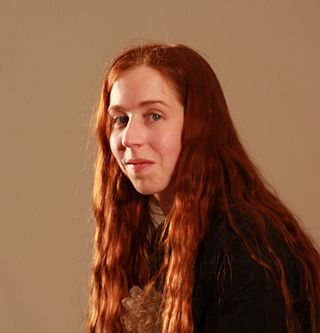
Cécile Corbel is a French and Breton singer, harpist, and composer. She has released five albums of original music and worked for Studio Ghibli as a composer for its 2010 film, The Borrower Arrietty. Corbel sings in many languages including French, Italian, Breton, and English and has done songs in Spanish, German, Japanese, Irish, and Turkish. Her lifelong partner is songwriter Simon Caby, who is also her co-composer.

Red Cardell is a French, Breton rock band, that mixes Breton music with rock, folk, blues, world music and chanson réaliste.

Pat O'May is a French musician who blends rock music with elements of world music. He originally worked with the heavy metal band Marienthal, and also produced several solo albums. He has written over 100 tracks for the TV show European coast seen from the sky. He participated in Alan Simon's rock operas Anne de Bretagne, Excalibur: The Celtic Rock Opera and started working with Martin Barre touring and recording with him.

L'Héritage des Celtes is a 50-piece Pan-Celt band with musicians from Celtic nations, started by two Bretons in the town of Quimper ; the producer Jacques Bernard and the guitarist Dan Ar Braz. It started as a gathering of friends to celebrate the 70th anniversary of Festival de Cornouaille in 1993. The adventure surpassed all expectations: 2.5 million albums sold, thousands of spectators in biggest stages of France and two Victoires de la Musique awards in 1996 and 1998. Their fame within France was so great that in 1996 they represented France in the 41st Eurovision Song Contest. In August 2000 the group played at the Festival Interceltique in Lorient where Dan Ar Braz announced that it would be the final concert.
Tri Martolod or Tri Martolod Yaouank, is a traditional Breton song which dates to the 18th century in Lower Brittany. It was made famous by the interpretation, the arrangement and the recordings made by the Breton harpist Alan Stivell, in the 1970s.
Pop-Plinn is a traditional air of a Breton dance transformed into pop music by Alan Stivell. The "Dañs Plinn" is a fast and physical dance where the dancer makes two small jumps by holding the arm of his neighbors.

The Festival de Cornouaille is an annual festival taking place in Quimper, a city in the south-west of Brittany, a western region of France. The festival begins on the third Sunday of July and lasts for one week. It has been held since 1923 and is one of the biggest cultural events in Brittany.

Emerald is the 23rd album by Breton musician Alan Stivell, released in 2009. The album celebrates Stivell's 40-year career since 1970's Reflets (Reflections), his first album as a singer. It's a return to the roots, a return to the violin and to folk-rock, and both an ever innovative approach, playing on electric harp and bagpipes prototypes and in musical arrangements that are as eclectic as they are original.
"Me zo ganet e kreiz ar mor" is an autobiographical poem by the Breton-language writer Yann-Ber Kalloc'h which celebrates the island of Groix, where he was born, and describes his parents' struggles and his own. In a setting by Jef Le Penven it has become one of the most popular Breton-language songs, performed by Alan Stivell, Yann-Fañch Kemener, Julie Fowlis and others. The title has several variants, including Me zo ganet e kreiz er mor and Me zo gañnet é kreiz er mor.














